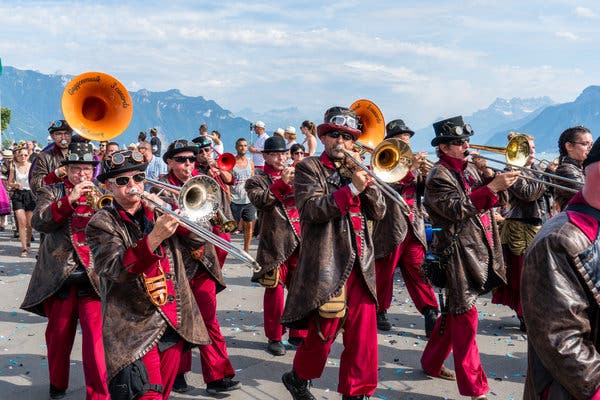The 52 Places Traveler

CreditSebastian Modak/The New York Times
The Swiss aren’t known for dancing all night to ABBA, but in the town of Vevey, the 52 Places Traveler found, every 20 years or so they let loose.
Our columnist, Sebastian Modak, is visiting each destination on our 52 Places to Go in 2019 list. Before Vevey, he was one of only four tourists in the Falkland Islands/Las Malvinas.
I arrived in Vevey, a small town that hugs the northeastern coast of Lake Geneva, so jet-lagged that I thought I might be hallucinating. I saw a human-sized starling posted up on a bar stool drinking a beer. A cow wearing a crown of flowers that would rival Carmen Miranda’s most flamboyant headpiece lumbered in my direction. Screaming at the top of their lungs, a gaggle of children dressed in the overalls of 18th-century farmhands, ran in circles.
Vevey’s Fête des Vignerons, or winegrowers’ festival, is a big deal, though most of the people under 30 that I spoke to in the days leading up to my arrival — including those from the German-speaking region on the other side of Switzerland — had no idea it existed. That could be because the last time it happened, we were 10 years old.
The celebration of local winemaking traditions prides itself on happening only “once in a generation,” roughly every 20 years, the exact date determined by a mysterious group called the Confrérie des Vignerons (Brotherhood of Winegrowers) that has been organizing the festivities since 1797. The quiet town of Vevey, usually a stopover as part of a tour of what is known as the Swiss Riviera, becomes the place to be for 25 days, not only for tourists but locals coming in from the surrounding cantons.
This year, organizers built a 20,000-capacity stadium, enough to fit the entire population of Vevey, smack dab in the center of town for the sole purpose of the daily show that is the festival’s main draw. The bottom of the arena is covered with the largest LED floor ever made, and the “stage” extends up and around the audience so that during the show, no matter where you’re looking, you’re seeing something. After August 11, the last day of the festival, the city will begin the three-month process of tearing down the stadium.
A spectacular of wine
Though I speak no French, I was able to glean the basic narrative of the three-hour proceedings. A grandfather sits with his daughter, explaining the life cycle of vineyards and what it takes to make wine. Along the way — and this is where I got a little lost — there are dance routines put on by playing cards and bugs; people dressed as starlings, foxes and rabbits; Swiss mercenaries in their medieval best; and one number that involved giant fish and an airborne fairy swooping across the arena. The 5,500 performers are mostly volunteers from the region and are joined by brass bands, an orchestra and a 950-strong choir.
It’s like the Olympic ceremony of wine — except it happens daily for almost a month. And it’s no coincidence that it brings that other spectacle to mind: The show’s director, Daniele Finzi Pasca, was responsible for the closing ceremonies at the Sochi and Turin Olympic Games.
But the mind-warping spectacle is really only a part of the festival, as I discovered over the course of four days (my planned schedule was truncated by a delayed departure from the Falkland Islands/Islas Malvinas).
Most of the fun and the same heavy dose of psychedelic weirdness happens outside the confines of the arena. Things tended to get going around noon — the thousands of revelers united in slow mornings after late nights — and by midafternoon
parades filled the street running along the lakeshore, blocked to traffic, with marching, halberd-carrying soldiers in full plate armor looking like they had just fallen out of some wormhole from the 14th century. Vendors sold food from across the world and I dug into more than one decadent baguette, hollowed out and filled with molten-hot fondue.
Every day of the festival, a different canton of Switzerland is represented — a crowd of wizard-looking men in cork top hats from Geneva one day, steampunk marching bands from Fribourg the next. One evening, I followed a fife and drum group from Basel as they barhopped across town, breaking into a full-on musical march between each stop.
If you go
-
There’s plenty to do in Vevey even when the party of a generation isn’t happening. For starters, this area was home to Charlie Chaplin from 1953 until his death in 1977. Reminders are everywhere: on postcards and T-shirts, and in the form of a statue right on the shore of the lake. To get fully immersed though, you’ll have to head to Chaplin’s World, a multimedia museum on the site of his former manor, a 30-minute walk from the center of town.
-
There are plenty of places to stay, from hostels to Airbnbs (my choice) to luxury hotels. If the city’s two five-star hotels are out of your budget — like everything in Switzerland, they go for a pretty penny — they are at least worth a visit. Start with the stunning Grand Hotel du Lac, which manages to channel throwback grandeur without the tackiness that sometimes comes with it. The summer Buddha Bar pop-up on the hotel’s front patio, overlooking Lake Geneva, is a good spot for a midafternoon break from the wine — to have a cocktail, instead.
-
You’ll have to wait quite a bit if you’re planning to get to the next Fête — it won’t be for at least 20 years, the exact date chosen within the next five. But it’s not too late to get to this one. The festival runs until August 11. Even if you can’t score tickets to the show, the free events spread across the old town and the general sense of celebration are draw enough.
Everything is transformed for the duration of the festival. You can grab a beer to go at the local bike shop, or mill around what is usually a furniture store sipping on white wine. Elsewhere, caveaux, underground wine cellars, have been converted into night clubs where after dark, the performers, still in costume, pump their fists to cheesy electro music.
It wasn’t long before I realized that the Fête is about far more than wine. In fact, the wine itself is an afterthought: most bars only served two white varietals, either from Lavaux, the Unesco-inscribed region that includes Vevey, or the adjacent La Cote. It’s a winegrowers’ festival not a wine festival, with vintners recognized for how they maintain their vines, fight diseases and pests, keep up with pruning. And it isn’t even about tradition either, though the throwback costumes seen on every corner are pivotal to the celebrations.
As Blaise Duboux, a member of the Brotherhood of Winemakers, and a 17th-generation winemaker, put it, it’s as much about keeping with the times as keeping the old ways alive.
“The Fête des Vignerons is on the Unesco list of intangible cultural heritage,” Mr. Duboux said. “To be intangible it can’t be stuck in history — it has to be alive, constantly changing. You can’t just think about the old ways. You have to be thinking of what maintaining the vines will look like in 20 years.”
And the Fête is changing with the times despite some resistance from some of the more traditionally minded members of the Brotherhood. This year, in the award ceremony, a woman won a gold medal and an organic wine producer won a silver medal, both firsts in the Brotherhood’s history.
The Swiss are known for many things, but letting loose and singing along to ABBA until dawn is not one of them. I experienced plenty of stereotypical Swiss efficiency during my brief stint there: My trains in and out of Geneva ran on time to the second. I had an incredibly frustrating conversation with a shopkeeper who wouldn’t sell me stamps for some postcards I had bought the day before because it was “against the rules” he had set for one stamp per card at the time of purchase (I didn’t get it either).
A break from the party
When I needed a breather from mornings filled with parades and nights that ended at 3 a.m., I learned what else is worth celebrating about this part of the world. For starters, there’s Lake Geneva, also known as Lac Léman. In the summer, it’s a giant, always-open swimming pool, the chairs built into its rocky shore an open invitation for the public to take a seat and watch the afternoon pass. I beat the heat (and the hangovers) like the Swiss do, jumping into the lake’s crystal clear water and floating amid the swans.
One afternoon, I took the funicular up to the peak of the 3,500-foot Mont Pèlerin, which looms over Vevey. Over the course of two hours I strolled back to town, through dense forests and into open grazing lands where the gentle clanging of cowbells was the only sound. Eventually I hit the Lavaux vineyards clustered around the village of Chardonne. Rows upon rows of vines were stacked up steep terraces and pedestrian paths wound through and around them, bringing me close enough to pick the grapes had I wanted to.
In the distance, I could see the arena, improbably rising out of the medieval skyline of Vevey’s old town. It was hard to imagine that just there, walking distance from this serenity, tens of thousands of people were having the times of their lives.







